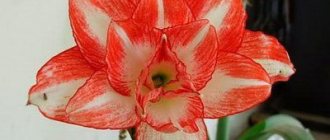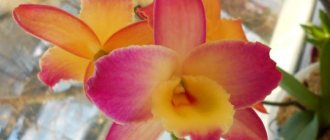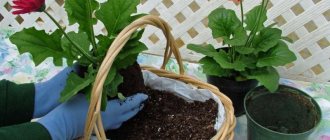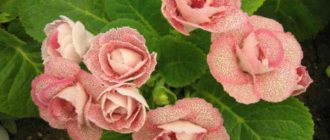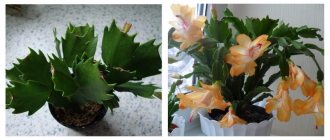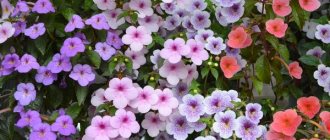Description
Appearance of flowers
Amaryllis is a perennial plant of the Amaryllis family. Its homeland is South Africa, but the flower is also found in Australia. Being a southern resident, it is unlikely to survive in the open soils of Russia. The exception is the southern regions, for example, the Krasnodar Territory. At home, they mainly breed selective varieties that have more luxuriant flowering.
Amaryllis is a bulbous plant; Corms remain viable for up to 20 years. The plant is very similar to another flower of the Amaryllis family - hippeastrum.
They can be distinguished by the shape of the bulb: in the latter it is less elongated and more flattened.
Other members of the family are clivia, zephyranthes, crinum, eucharis, vorsia, hymenocallis.
Amaryllis, which has long been classified as a lily, has elongated dark green leaves up to 50-60 cm in length and 3 cm in width. There are practically no leaves on the peduncle, which is why the plant has the nickname “naked lady”.
On each peduncle (their number from one bulb is 1-3 pieces), from 4 to 12 buds grow , which then turn into luxurious flowers up to 10-12 cm in diameter. The color is varied: white, scarlet, lilac and pink, the number of petals also varies.
It is believed that amaryllis growing in nature does not smell. But the domestic varieties bred by breeders have a subtle delicate aroma.
Lilac-pink inflorescences
The bulbs of this elegant plant contain a dangerous compound – a poisonous compound. To avoid the toxin entering the body, you need to wear protective gloves and then wash your hands thoroughly. Also, children and animals should not be allowed near the flower.
Types and varieties
Flower variety "Aphrodite"
Amaryllis is a monotype: in nature there is only one type of plant - Amaryllis belladonna (from Italian Belladonna - “Beautiful Lady”). However, through the efforts of breeders, numerous hybrids of beautiful shades have been obtained.
The most popular and vibrant varieties of amaryllis:
- "Durban": large red flowers with white streaks
- "Parker": bright pink flowers with a yellowish throat
- “Nymph”: flowers of soft pink tones with a pleasant doubleness
- "Snow Queen": luxurious and large snow-white flowers
- "Red Lion": large bright red flowers
Other popular varieties include “Vera”, “Macarena”, “Double Dream”, “Aphrodite”, “Gervase” and “Ferrari”.
Landing
Amaryllis is a real decoration for your interior
There are two ways to grow amaryllis at home: seeds or bulbs. But first you need to prepare a container for the flower and select a soil mixture.
Choosing a pot
Flowers in clay pots
It is recommended to choose a heavy and stable pot for your amaryllis. A small plastic vessel is not entirely successful: the plant grows a lot of leaves, and during the flowering period it is also crowned with a lush “cap” of flowers.
There is a risk that, under the force of its own gravity, the amaryllis will begin to bend or even fall. A ceramic pot is ideal: it provides the roots with the right amount of air and is quite stable.
The size of the container is selected according to the size of the onion: the distance from it to the walls should be about 4 centimeters. A pot that is too large will delay flowering time. It is advisable to choose a fairly deep pot: the root system of the bulb goes deep. Before planting, the container must be washed well, or better yet, sterilized.
The pot should have a drainage hole at the bottom to drain excess water. This way the plant is less at risk of developing root rot. A drainage layer of expanded clay, pebbles and gravel is also laid at the bottom.
Amaryllis at home
Amaryllis is suitable for growing at home. All existing types are adapted to a temperate climate, which can easily be created in an apartment.
Fuchsia indoor flower - plant varieties
To make the plant feel comfortable, it is necessary to provide:
- Constant access to sunlight, avoiding direct rays;
- Moderate watering in the hot season;
- Almost complete cessation of soil moisture during wintering;
- Feeding during the period of flowering and increased growth, its absence in the winter season, when at rest.
Note! The plant loves diffused sunlight, so to wake it up after hibernation, just place it closer to the window. The flower will feel the change and wake up and begin to grow. When the plant comes to life, you need to start feeding it with special fertilizer and increase watering. If it is satisfied with the conditions of its maintenance, it will delight you with flowering several times a year.
After the end of the period, feeding stops. The leaves begin to fade, and the plant goes to “winter.” The bulb collects the necessary nutrients for further growth, so there is no need to cut off the remaining leaves.
In spring and summer, plants are propagated:
- seeds;
- vegetatively using a flower bulb.
All types of plants take root well at home, as they do not tolerate frost and drafts. There is much less variety when it comes to garden amaryllis. Plants suitable for planting in open ground include the following varieties:
- Durban;
- The Snow Queen;
- Macarena;
- Grandior.
In winter, you need to organize a warm place for them; the bulbs will die outside. Since amaryllis is a perennial, having endured the cold at moderate temperatures, it will begin to bloom again in the spring.
Priming
When choosing soil, it is important to pay attention to its composition.
Soil mixture for bulbs can be purchased at a flower shop or prepared yourself. The main thing is that it is nutritious and sterile.
The most successful soil composition for amaryllis is a mixture of turf soil, leaf soil, humus and sand - all in equal proportions. It is permissible to prepare a mixture of peat, sand, leaf and turf soil and humus.
Growing from seeds
Propagation by seeds
Seeds are formed during pollination, when pollen from the stamens of one plant is transferred to the pistil of another. Each box contains 50-80 seeds. Features of the first breeding method:
- Flowering begins only five or six years after planting
- The bulb remains viable longer
- Varietal qualities are not preserved
Seeds must be taken fresh, no older than five weeks. There is no need to dry them: the number of seedlings may decrease. The seeds are lowered into the ground and lightly sprinkled with earth in a layer no thicker than 0.5 cm. The optimal temperature for seedling germination is +23-25°C.
The seeds will sprout in 1.5-2 months. When the sprouts have two leaves, they are planted in separate pots.
How to propagate and replant amaryllis?
It is possible to propagate the plant with the help of children, which after a couple of years will become adult bulbs and begin to bloom.
A more complex method is to grow amaryllis from seeds. It is necessary to pollinate the pistil with pollen from the stamen with a brush. After about 30 days, the seeds ripen on the peduncle box, which then need to be planted in the soil.
After just 30 days, you can get the first shoots, which should then be transplanted into separate pots. But amaryllis from seeds will bloom only after five years.
The size of the amaryllis pot directly depends on the diameter of the bulb. It should be slightly wider than its volume, about 2 centimeters on all sides.
The plant should not be replanted more often than three years after the end of flowering.
How to take care of indoor flowers in the fall: useful tips and tricks
- How to choose a bouquet for March 8: the meaning of flowers and their quantity
TOP 10 best flowers as a gift on March 8
Growing from bulbs
Growing from a bulb
It is the bulbous method of propagation that gardeners prefer. Amaryllis blooms within 2-3 years after planting. The finished bulbs of the mother plant are placed in a substrate similar to the one in which the “parent” grows.
You can plant several bulbs in one pot, leaving a gap of 2-3 cm between them. When the plants bloom at the same time, they will look even more spectacular.
Amaryllis bulbs
Planting stages:
- Selection of planting material. Daughter bulbs must be healthy, with strong roots, have no traces of rotting or mold, or an unpleasant or sweetish odor.
- The onion is cleaned of dirty or damaged husks and dipped in a manganese solution.
- The planting material is dried after the solution for 12-24 hours
- Pour the substrate halfway into the prepared pot, lower the bulb into it with the blunt end down
- Fill the sides with soil: about a third of the bulb remains above ground level
- The earth is crushed with palms and watered. If desired, you can mulch with small stones
Amaryllis rejuvenation is done by dividing the bulb. To do this, divide it into 4-8 parts, without cutting to the base and trying to preserve the scales. Then they are planted and germinated in the usual way.
If everything succeeds, a new sprout will appear on each of the parts. If not, the bulb will die. Propagating in this way is risky: you can be left without amaryllis and without a bulb.
Reproduction
Like other bulbous plants, amaryllis reproduces in two ways - by seeds and daughter bulbs, which are separated from the mother bulb during transplantation. This is the simplest and most reliable method of propagation, which guarantees complete preservation of varietal characteristics. To plant daughter bulbs, take the same pot as for 4-5 year old bulbs, the soil mixture and depth should be similar to the mother bulb. Young plants develop very quickly; it can take 3 years from separation to flowering.
Lower temperatures will extend the flowering period
Propagation by seeds is a longer process (flowering will occur only in the 7th year) and complex. To obtain seeds, you will have to pollinate the flower yourself and wait about a month (that is how long the seeds continue to ripen). Since the seeds remain viable for only 5-6 weeks, there is no need to delay planting them. Seeds are planted in well-moistened soil; seedlings will appear in about a month.
Replant the flower during the dormant period of the bulbs
Another widely practiced method of propagation is dividing a large onion, the main thing being that each division has several old scales and a piece of the bottom. The onion is cut into several parts using vertical cuts; the sections must be immediately sprinkled with crushed activated carbon or ash. You can insert knitting needles between the segments, along the cuts, so that the divisions form faster (photo 2)
Photo 2. Dividing an amaryllis bulb.
After about a month, the first leaves should appear on the cuttings; after the second one appears, they can be finally separated and planted separately in loose soil.
Unusual and original flowerpot in the form of a cup and saucer
Care
When the plant sprouts, all that remains is to provide proper care. This is not difficult, given the unpretentiousness of amaryllis.
Temperature
In terms of thermoregulation, everything is simple for amaryllis: the usual room temperature of +20-25°C is suitable for it. It does not tolerate cold air well during active growth phases.
During the dormant period, it needs cooler conditions - up to +10-13 degrees. An important requirement when growing amaryllis is constant temperature: the plant does not like sudden changes. But regular ventilation will have a positive effect on his well-being. The main thing is to avoid drafts.
When amaryllis begins to bloom, you can lower the temperature slightly. This will allow you to extend the flowering period.
Lighting
Photo of flowers on the windowsill
Amaryllis comes from warm, sunny climes. Therefore, the plant is light-loving; a lack of ultraviolet light will lead to little or no flowering.
It is better to choose a south-east, south or south-west window for the pot. During active growth phases, it is necessary to provide amaryllis with diffused sunlight for 14-16 hours. Direct sunlight is undesirable: the petals may turn pale and fade.
The plant reaches towards the sun, so the pot will have to be rotated regularly. In the resting phase, amaryllis does not require any additional lighting conditions.
Watering and spraying
Moisturizing the earth
Amaryllis is a moisture-loving flower, so regular watering is required. You can only use soft, settled water at room temperature.
It is permissible to water through a tray. The soil must remain moist, but not excessively: otherwise the roots of the onion will rot. Particularly thorough watering is provided during the period of flower activity.
During the dormant period - which usually occurs in winter - watering is stopped. It is enough just to spray the soil in the pot around the bulb. The dormant period ends when the plant shoots out a new peduncle. From the moment of its germination to 7-10 cm, watering is gradually resumed.
In the room where the pots with “dormant” bulbs are located, the humidity level should be 60-70%.
Amaryllis can be sprayed, and it is permissible for water to get on the flowers: it does not harm them. During active growth phases, the recommended humidity level in the room is up to 80%.
Top dressing
Feeding plants is a necessary process
Amaryllis is fertilized only during the growing season. To do this, purchase liquid mineral or organic fertilizers from a specialized store. Mullein or bird droppings are added as organic matter.
It is desirable that purchased mineral mixtures contain little nitrogen: the element promotes abundant foliage growth, but flowering, on the contrary, will be poor. But there should be a lot of phosphorus and potassium. You need to feed the flower once every two weeks.
Transfer
Transplantation process
An adult amaryllis is replanted every 3-4 years. In other cases, it is enough to update the top layer of the substrate in the pot. It is permissible to transplant only when flowering has ended and the flower stem has withered. The transplant is carried out as follows:
- A few days in advance you need to ensure good watering.
- The amaryllis is removed from the pot and the roots of the plant are examined. If there are rotting or damaged areas, they will have to be carefully removed with a sterile knife.
- The cut sites are treated with an aseptic preparation. Activated carbon can be used
- If there are tubers on the bulb, they must also be carefully removed so that they do not interfere with the growth of the parent plant
- Then the bulb is transplanted into a new larger pot, drainage is placed at the bottom
Trimming
Pruning an indoor flower
There is usually no need to prune amaryllis. Nutrients from fading foliage move to the plant's bulb, where, like in a pantry, they are stored until the next flowering period.
Dried leaves usually fall off on their own. If this does not happen, they are carefully removed at the very base or bent to the ground.
Rest period
Amaryllis after flowering
When the active phase is over, flowering ends, then the stem and leaves die. The plant needs to gain strength in order to please the owner with its blooming appearance again.
To do this, after the leaves and peduncle die off, the bulbs are mixed for rest in a cool, dark, dry room, for example, in a basement or cellar. The main thing is to ensure constant temperature and humidity levels.
general characteristics
Previously, hippeastrum was classified as amaryllis. Now it represents a separate genus of bulbous plants. Hippeastrum is a flower with leaves like amaryllis, they appear before flowering. In amaryllis they form during the growth process. They are absent during flowering.
Indoor amaryllis
Representatives of the Amaryllidaceae family (amaryllidaceae) attract attention with large flowers that spread a rich aroma. They prefer to live in temperate climates and cannot tolerate cold.
The amaryllis flower originated in South Africa and quickly spread throughout the world due to its attractiveness. Reminds me of a garden lily. The bright colors of the petals and thin long leaves really resemble the famous plant. Amaryllis is even called a house lily.
Additional Information. Great artists tried to convey the beauty of the plant. For example, a widely known sketch of a lily, reminiscent of an indoor amaryllis, created by Leonardo da Vinci. The name is widely used to attract the attention of tourists. For example, there are hotels called “Amaryllis” in Rhodes, Vietnam.
The bulb of the plant produces a long stem, the height of which exceeds 40 centimeters. An inflorescence forms on it. The leaves are dark green and begin to grow from the root. Flowers are formed in several pieces, the number reaches 12. There are varieties that differ in petals, their width and shape. There are usually 6 of them in total; when connected, they form a funnel. Amaryllis flowers come in a variety of shades, from white and pink to deep purple. Varieties with a large number of petals have been bred.
How many times a year amaryllis blooms depends on the conditions created in the room. The plant loves:
- bright but diffused sunlight;
- moderate watering.
Important! A prerequisite for flowering is rest in the winter season. During the hibernation period, the flower gains strength and by the beginning of spring it is ready to delight the household. During rest, stay in a cool room, with a temperature of 12-16 degrees.
There is a legend explaining the appearance of the name. It contains a description of the life of a nymph named Amaryllis, who captivated the hearts of all men on earth. The God of Autumn fell in love with the girl, and in order to hide her from other men, he turned her into a beautiful flower. The insidious lover did not stop there; he infused the plant with poison. Since then, whoever touched the beautiful flower died.
Why doesn't the plant bloom?
Beautiful bloom
Since amaryllis are grown at home specifically for their beautiful blooms, the lack of flowers can surprise and disappoint the owner. The plant does not want to bloom for various reasons:
- The pot is large in size, which is why babies form on the bulb, taking all the strength of the plant
- The bulb is too deep in the ground
- The plant lacks nutrients, needs to be fed
- Care errors and poor conditions: amaryllis does not have enough light, heat, it is not sufficiently moistened or, conversely, it is over-moistened. It is necessary to reconsider watering and illuminate the plant with phytolamps
- Poor condition of the roots, which do not allow nutrients to enter the bulb, leaves and peduncle
- The plant was not at rest long enough and did not have time to accumulate strength
- Young age of bulbs
- Damage by diseases or pests
You can achieve flowering at the right time using forcing. The period from December to April is best suited for this.
Diseases and pests
Leaf damage by thrips
Signs of disease - leaves turn yellow, spots appear on them, a noticeable cessation in growth, and lack of flowering. Amaryllis is most often affected by the following diseases:
- K red burn (staganosproz). This fungal disease appears as red spots on the leaves. The plant must be isolated, disinfected in a solution of potassium permanganate and dried. Often the disease is the result of waterlogging: watering should be reduced
- Anthracnose. A sign of the disease is that the leaves become covered with brown spots and dry out. The damaged parts are cut off, the plant is treated with a Fungicide, and watering is reduced.
- Gray rot. Amaryllis smells unpleasant and leaves have grayish or brown spots. You will have to dig up the bulb, remove damaged areas, treat it with Fundazol, and replant it in a new pot with clean soil. Watering again needs to be reduced
- Root rot (fusarium). Root rot can quickly kill a plant. The measures are the same as for the treatment of gray rot
Mealybug
The following insects parasitize the leaves and stems of amaryllis:
- Thrips
- Aphid
- Mealybug
- Amaryllis mealybug
- Spider mite
- Onion mite
- springtail
- Scale insect and false scale insect
Pests manifest themselves by yellowing and spots on the leaves, and the plant withers. Some, for example, aphids, scale insects, and spider mites, are noticeable when examining amaryllis.
To eliminate the problem, treatment is carried out with a solution of soap and alcohol and insecticides: Fitoverm, Fundazol, Iskra, Kleschevit, Aktara.
Luxurious interior addition
The best way to prevent diseases and pests is to follow the recommendations for watering, fertilizing, and sterilizing the plant, pot, and working tools.
Transfer
The flower does not require annual replanting into a new container; it is enough to replace the top layer of soil with fresh substrate every year.
Once every 3–4 years, the amaryllis needs to be transplanted into a new container, at the same time separating the baby from the bulb. In order for the plant to tolerate the transplant well, 3 days before the operation, it is watered abundantly. Carefully remove the flower from the pot and shake off the soil from the roots. The bulb and roots are examined most carefully.
All dried, rotten parts are cut off, the sections are treated with brilliant green or dusted with charcoal.
PHOTO GALLERY
Customer ratings: Be the first!

